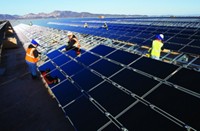Advertisement
Grab your lab coat. Let's get started
Welcome!
Welcome!
Create an account below to get 6 C&EN articles per month, receive newsletters and more - all free.
It seems this is your first time logging in online. Please enter the following information to continue.
As an ACS member you automatically get access to this site. All we need is few more details to create your reading experience.
Not you? Sign in with a different account.
Not you? Sign in with a different account.
ERROR 1
ERROR 1
ERROR 2
ERROR 2
ERROR 2
ERROR 2
ERROR 2
Password and Confirm password must match.
If you have an ACS member number, please enter it here so we can link this account to your membership. (optional)
ERROR 2
ACS values your privacy. By submitting your information, you are gaining access to C&EN and subscribing to our weekly newsletter. We use the information you provide to make your reading experience better, and we will never sell your data to third party members.
Environment
Harnessing The Sun
Solar Power: Energy Department event showcases the possibilities of advanced solar power technology
by Jeff Johnson and Kenneth Moore
October 26, 2009
| A version of this story appeared in
Volume 87, Issue 43

A home wrapped in solar panels won this year’s Solar Decathlon, put on by the Department of Energy on the National Mall, in Washington, D.C. The competition, held on Oct. 8 to 18, brought together teams of students from Canada, Germany, Puerto Rico, Spain, and the U.S. to showcase how energy technologies can be incorporated into a real home.

The competition, which began in 2002, invites architecture and engineering students and faculty to design energy-efficient homes and assemble them on-site. This year marked the first time the houses were tied to the electric grid rather than backed up by batteries. This change is significant because homes that generate excess electricity can put it back on the grid.
The teams competed for points in 10 categories of sustainability and practicality, with electricity production carrying the most weight. Despite cold and rainy weather, the event attracted more than 200,000 people.
Technical University of Darmstadt’s Team Germany brought in the big photovoltaic guns and won the contest. The team’s home was encased in photovoltaic cells: 250 thin-film copper indium gallium diselenide (CIGS) panels lined the four outer walls, and 40 monocrystalline silicon panels sat on the roof. In all, the “surPLUShome,” as the team calls it, could generate 19 kW of power at peak production—four to six times more than usual residential rooftop installations.
The German students’ goal, the team said, was to push the technological envelope, and their reliance on CIGS panels paid off. These panels have the advantage of being more efficient than silicon panels on overcast days. But the roof’s silicon panels produced the most electricity overall, architecture team member Patrick Tauchert tells C&EN. During the almost-two-week period the panels were operating, the house produced 400 kWh of electricity but used only 260 kWh.
Some other teams used more affordable technology. For instance, Rice University students developed a prototype row house, capable of producing 4.2-kW of power, at a cost of $200,000, a fraction of the surPLUShome’s estimated $650,000 to $850,000 price tag. The Rice team plans to build a prefabricated version of the prototype for $80,000 when they return to Texas.



Join the conversation
Contact the reporter
Submit a Letter to the Editor for publication
Engage with us on Twitter